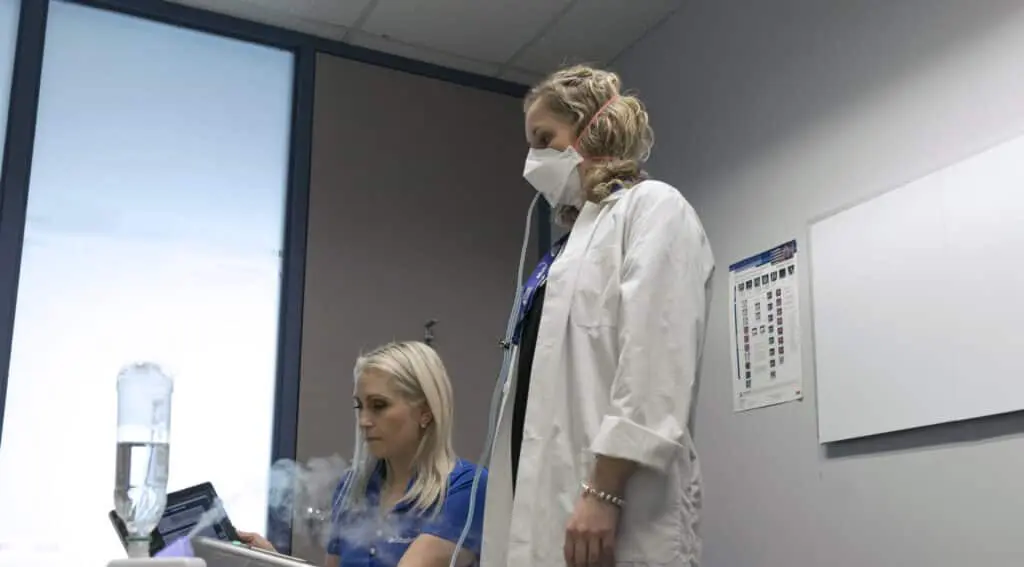
A quantitative respirator fit test (QNFT) uses specialized assessment tools to numerically quantify the amount of leakage, if any, from a specific respirator’s face seal.
In QNFT, a tiny hole is punched into the respirator, so the following OSHA-approved tests can be performed:
- Generated Aerosol: Uses generated aerosol to measure the concentration of particles outside and inside the respirator to determine the fit factor.
- Ambient Aerosol Condensation Nuclear Counter (CNC): CNC testing involves measuring the concentration of ambient microscopic dust particles entering the respirator.
- Controlled Negative Pressure: This test involves cutting off the air supply, which temporarily creates negative pressure inside the respirator. If vacuum pressure decays, this identifies potential leaks within the mask.
Each type of QNFT uniquely assesses a respirator’s sealing efficacy. Quantitative valuation of a given respirator yields a score known as the “fit factor,” which estimates the ratio of a potentially harmful substance’s concentration in the ambient atmosphere relative to its concentration inside the device when in use.
Routine respirator testing is critical for every company that uses these breathing aids to protect employees from hazardous substances in the workplace. Workers are more likely to be exposed and develop symptoms if respirators aren’t tested regularly and accurately.
Which Respirators Need Quantitative Respirator Testing?
Federal regulations require quantitative fit testing for all full-face respirators and some half-face devices, including:
- High-Efficiency Particulate Air (HEPA) Respirators
- Self-Contained Breathing Apparatus (SCBA)
- Elastomeric Half Mask Respirator (EHMR)
- Atmosphere Supplying Respirators (ASR)
- Particulate Filtering Respirators (PFR)
- Filtering Facepiece Respirators (FFR)
- Combination SAR/SCBA Respirators
- Air-Purifying Respirators (APR)
- Supplied-Air Respirators (SAR)
The National Institute for Occupational Safety and Health (NIOSH) requires quantitative respirator fit tests for all full-face, negative-pressure respirators when they are used to filter airborne pollutants with concentrations between 10 and 50 times the permissible exposure limit (PEL).
The Occupational Safety and Health Administration (OSHA) also mandates that QNFT is required whenever the fit factor is 500 or more for full-face respirators and whenever the fit factor is at least 100 for half-face respirators.
How Often Should Respirator Fit Tests Be Done?
According to guidelines established in OSHA 1910.134(f)(3), respirator testing should be conducted at least once annually, when a new employee is hired, and when a company switches respirator brands.
Fit testing must also be performed whenever an employee, employer, physician, or other health care professional reports or observes any changes that could affect the way an employee’s respirator fits— including novel instances of facial scarring, cosmetic surgery, dental procedures, facial hair growth, and/or obvious changes in body weight.
Regulatory Requirements
Some primary federal regulations concerning quantitative respirator fit tests include:
- QNFT must achieve a fit factor of at least 100 for tight-fitting, half-face respirators and a fit factor of at least 500 for full-face respirators.
- QNFT is mandated for negative pressure respirators to be used when a contaminant is at least 10 times the PEL.
- Atmosphere-supplying respirators and air-purifying respirators are tested in the negative pressure QNFT mode.
- QNFT is performed on the same make, style, model, and size of respirator the employee will use.
- An employee may request retesting if conditions change and the respirator becomes objectionable.
Additionally, the appropriate respirator must be available when needed, maintained in proper working order, and stored according to the manufacturer’s guidelines. And each employee who will use a respirator during work must be deemed physically capable of doing so by an appropriately licensed medical professional.
There are numerous other rules and regulations that pertain to quantitative respirator fit tests. If you want to know more about the federal regulations for QNFT, click here to view OSHA 1910.134 (a)(2).
OSHA’s Fast Fit Protocol
In 2019, OSHA revised regulations regarding Ambient Aerosol Condensation Nuclei Counter (CNC) Quantitative Fit Tests for full-facepiece and half-mask elastomeric respirators and filtering facepiece respirators. Called the Fast Fit Protocol, this new change allows for faster and shorter CNC testing. The previous CNC test called for eight exercises, while new testing only requires four of the original eight exercises.
Although tests can be performed more quickly, quality is not compromised as all tests and exercises must be performed the same way to be valid.
Manufacturers like Accutec offer advanced-fit testing systems that allow you to quickly and easily complete QNFTs. You must follow OSHA’s required protocol when using advanced-fit testing systems like Accutec.
Fast Fit Requirements
Requirements for this protocol include:
- Choosing a respirator that fits the employee comfortably.
- Ensuring your employee is wearing all standard safety equipment, in addition to the respirator.
- Teaching the employee how to correctly wear and use a respirator, including adjusting strap tension and checking that the respirator fits.
- Performing a comfort assessment.
- Performing a seal check. If the employee fails the seal check, they must choose another respirator.
- Performing CNC testing outlined in 1910.134, which includes having the test subject bend over, talk, and move their head side to side and up and down.
Let a Professional Handle Your Respirator Fit Testing
The importance of compliant quantitative respirator testing can’t be overstated. Substandard performance in this area puts employees at risk of exposure to dangerous substances and puts your operation at risk of violations. Sickness, injury, permanent disability, and death are possible outcomes. That’s why it’s imperative to work with a group of professionals like Archview Services to ensure long-term, fluent QNFT success.
We provide gas detection and measurement equipment, confined space equipment, respirator evaluations, respirator fit testings, and more to operators in Arkansas, Illinois, Iowa, Kansas, Missouri, Nebraska, and Oklahoma. Contact us today to learn more about our capabilities or schedule on-site respirator fit testing. We’re here to assist!
